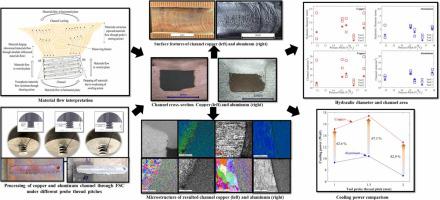CIRP Journal of Manufacturing Science and Technology ( IF 4.8 ) Pub Date : 2024-01-25 , DOI: 10.1016/j.cirpj.2024.01.002 Milap Pandya , Nirav P. Patel , Kush P. Mehta

|
Manufacturing for next-generation thermal management is very important for electrical and electronics industries to meet sustainable development goals through electrification. In this study, thermal management manufacturing application and analysis of channel formation characteristics for copper and aluminum materials are investigated using different tool designs consisting of three probe thread pitches and four process pitches of the Friction Stir Channeling (FSC) process. Channel characteristics such as shape, area, perimeter, and closing angle are investigated. Analysis of microstructure around the channel using optical microscopy and electron beam scattered diffraction, Vickers hardness measurements at channel cross-section, surface features, and roughness inside channels are conducted. Eventually, the FSCed channels are evaluated for thermal efficiency performance. Complex materials flow with the combined effect of materials extraction and forging through stirring followed by shearing action is revealed as the channel formation mechanism in FSC. The higher thread pitch on the tool probe resulted in non-uniform material flow during channel formation and eventually formed non-rectangular channels. At the interface of the ceiling zone-unprocessed region in copper, intriguing features of piling up grain boundaries, low angle grain boundaries, and higher kernel average misorientation are observed. Unique surface roughness textures are noticed for four different walls of channels in copper and aluminum. The aluminum channel's root mean square roughness (Rq) value is 63.4% rougher on the retreating side and 246% rougher on the ceiling side compared to the copper channel at the same location. The channel produced by the 1.5 mm thread pitch tool was found to be the most efficient in terms of cooling power for both copper and aluminum materials. For Channels fabricated by thread pitches of 1.0 mm, 1.5 mm, and 2.0 mm in copper were found to be 62.4%, 67.3%, and 82.9% more efficient than aluminum channels.
中文翻译:

工具设计影响下的沟道形成特征及铜铝材料搅拌摩擦沟道对比分析
下一代热管理制造对于电气和电子行业通过电气化实现可持续发展目标非常重要。在本研究中,使用不同的工具设计(包括搅拌摩擦通道(FSC)工艺的三个探针螺距和四个工艺螺距)研究了铜和铝材料的热管理制造应用和通道形成特性分析。研究了形状、面积、周长和闭合角度等通道特征。使用光学显微镜和电子束散射衍射分析通道周围的微观结构,测量通道横截面的维氏硬度、表面特征和通道内部的粗糙度。最终,FSCed 通道的热效率性能得到评估。通过搅拌和剪切作用,复杂材料的流动以及材料提取和锻造的综合作用被揭示为 FSC 中的通道形成机制。工具探针上的较高螺距导致通道形成期间材料流动不均匀,并最终形成非矩形通道。在铜的顶部区域-未处理区域的界面处,观察到堆积晶界、小角度晶界和较高的晶粒平均取向差的有趣特征。铜和铝的四种不同通道壁具有独特的表面粗糙度纹理。与同一位置的铜槽钢相比,铝槽钢的均方根粗糙度 (R q ) 值在后退侧粗糙度高 63.4%,在天花板侧粗糙度高 246%。研究发现,对于铜和铝材料而言,1.5 毫米螺距工具产生的通道在冷却能力方面是最有效的。对于采用 1.0 毫米、1.5 毫米和 2.0 毫米螺距的铜制成的通道,其效率比铝通道高 62.4%、67.3% 和 82.9%。



























 京公网安备 11010802027423号
京公网安备 11010802027423号